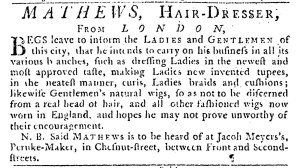What was advertised in a colonial American newspaper 250 years ago today?

“Gentlemen’s natural wigs … and all other fashioned wigs now worn in England.”
In December 1773, “MATHEWS, HAIR-DRESSER, FROM LONDON,” introduced himself to prospective clients in Philadelphia via advertisements in the Pennsylvania Gazette and the Pennsylvania Journal. He informed “LADIES and GENTLEMEN of this city, that he intends to carry on his business in all its various branches.” That included “dressing Ladies in the newest and most approved taste,” no doubt drawing on his connections to London to make sure they followed the latest trends, and “making Ladies new invented tupees, in the neatest manner.” He also made “natural wigs” for gentlemen, “so as not to be discerned from a real head of hair,” as well as “other fashioned wigs now worn in England.” His clients, Mathews suggested, could depend on looking as sophisticated as their cosmopolitan cousins in the capital of the empire.
Mathews had several choices for disseminating this message. He opted for two newspapers, increasing the number of readers who would see his advertisement compared to publishing it in just one. In addition to the Pennsylvania Gazetteand the Pennsylvania Journal, he could have placed it in the Pennsylvania Chronicle and the Pennsylvania Packet. The cost of advertising may have prevented him from running notices in all four English-language newspapers published in Philadelphia at the time (and he likely considered advertising in the Wöchtenliche Pennsylvanische Staatsboteimpractical, even though the printer translated advertisements gratis). Yet why did he choose the Pennsylvania Gazetteand the Pennsylvania Journal over the others? The printers distributed those two newspapers on Wednesdays, while the printers of the Pennsylvania Chronicle and the Pennsylvania Packet distributed their publications on Mondays. Mathews did not aim to have his advertisements spread out on different days, but that may not have mattered much in the context of weekly rather than daily publication. Perhaps the cost of advertising influenced his decision, but that may not have been the case. Although none of the printers included advertising fees in their colophons, they likely offered competitive rates. All of them except for the Pennsylvania Gazette did include the annual subscription cost in their colophon. The consistency, ten shilling for each of them, suggests that they set similar fees for advertising. Perhaps Mathews selected the Pennsylvania Gazette and the Pennsylvania Journal because he believed they had a wider circulation or reached more of the local gentry that he hoped to cultivate as clients. His example raises a larger question about why any advertiser in cities with multiple newspapers (including Boston, Charleston, New York, and Williamsburg) chose one over another or some over others to run their notices.
